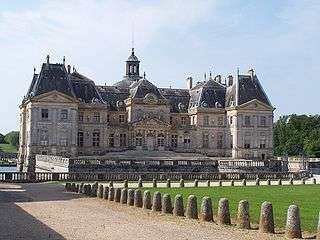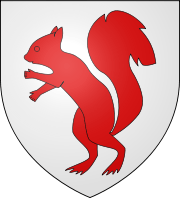Nicolas Fouquet
| Nicolas Fouquet | |
|---|---|
|
Portrait by Charles Le Brun | |
| Born |
27 January 1615 Paris |
| Died |
23 March 1680 (aged 65) Pignerol |
| Nationality | France |
| Known for | Superintendent of Finances in France |
Nicolas Fouquet, marquis de Belle-Île, vicomte de Melun et Vaux (27 January 1615 – 23 March 1680) was the Superintendent of Finances in France from 1653 until 1661 under King Louis XIV. He fell out of favor with the young king, probably because of his extravagant displays of wealth, and the king had him imprisoned from 1661 until his death in 1680.
Early life
Nicolas Fouquet was born in Paris to an influential family of the noblesse de robe and, after some preliminary schooling with the Jesuits at the age of 13, was admitted as avocat at the Parlement of Paris. While still in his teens, he held several positions of responsibility, and in 1636, at just 20, he was able to buy the post of maître des requêtes for 150,000 livres. In 1640, he married the rich Louise Fourché, who died a year later.[1]
Political career
From 1642 to 1650, he held various intendancies, at first in the provinces and then with the army of chief minister Cardinal Mazarin and, coming thus in touch with the court, was permitted in 1650 to buy the important position of procureur général to the parlement of Paris. During Mazarin's exile, Fouquet remained loyal to him, protecting his property and keeping him informed of the situation at court.
Upon Mazarin's return, Fouquet demanded and received as reward the office of superintendent of the finances (1653), a position that, in the unsettled condition of the government, threw into his hands not merely the decision as to which funds should be applied to meet the demands of the state's creditors but also the negotiations with the great financiers who lent money to the king. The appointment was a popular one with the moneyed class, for Fouquet's great wealth had been largely augmented by his marriage in 1651 to Marie de Castille, who belonged to a wealthy family of the legal nobility in Spain. Fouquet received around 160,000 Livres from the marriage dowry.
His own credit, and above all his unfailing confidence in himself, strengthened the credit of the government, while his high position at the parlement (he still remained procureur général) secured financial transactions from investigation. As minister of finance, he soon had Mazarin almost in the position of a supplicant. The long wars, and the greed of the courtiers, who followed the example of Mazarin, made it necessary at times for Fouquet to meet the demands upon him by borrowing upon his own credit, but he soon turned this confusion of the public purse with his own to good account.
The disorder in the accounts became hopeless; fraudulent operations were entered into with impunity, and the financiers were kept in the position of clients by official favours and by generous aid whenever they needed it. Fouquet's fortune now surpassed even Mazarin's, but the latter was too deeply implicated in similar operations to interfere, and was obliged to leave the day of reckoning to his agent and successor Jean-Baptiste Colbert.
His closest friend, and maybe mistress, was Suzanne de Rougé, the Marquise du Plessis-Bellière.
Vaux-le-Vicomte

Upon Mazarin's death in 1661, Fouquet expected to be made head of the government; but Louis XIV was suspicious of his poorly disguised ambition, and it was with Fouquet in mind that he made the well-known statement, upon assuming the government, that Louis would be his own chief minister. Colbert, perhaps seeking to succeed Fouquet,[2] fed the king's displeasure with adverse reports upon the deficit and made the worst of the case against Fouquet.
The extravagant expenditures and displays of the superintendent's wealth served to intensify the ill will of the king. Fouquet had bought the port of Belle-Île-en-Mer and strengthened the fortifications with a view to taking refuge there in case of disgrace. He had spent enormous sums in building a magnificent château on his estate of Vaux-le-Vicomte, which in extent, magnificence and splendour of decoration was a forerunner of the Palace of Versailles and where he brought together three artists that the King would later take up for Versailles: the architect Louis Le Vau, the painter Charles Le Brun, and the garden designer André le Nôtre. Here he gathered the rarest manuscripts, paintings, jewels and antiques in profusion, and above all surrounded himself with artists and authors. The table was open to all people of quality, and the kitchen was presided over by François Vatel. Jean de La Fontaine, Pierre Corneille and Paul Scarron were a few of the many artists who enjoyed his patronage.
The coat of arms of Fouquet's family traditionally showed a squirrel and bore the motto "Quo non ascendet?" ("What heights will he not scale?"). The symbol can be found in many rooms and decorations at Vaux-le-Vicomte. The choice of this animal derives from the name foucquet, which in the dialect of Angers (in the west of France) means squirrel.

Arrest, trial and life imprisonment

In August 1661, Louis XIV, already set upon Fouquet's destruction (his disgrace was secretly decided upon on 4 May[3]), was entertained at Vaux with a fête rivaled in magnificence by only one or two in French history, at which Molière's Les Fâcheux was produced for the first time. The splendour of the entertainment sealed Fouquet's fate. The king, then only 22 years old, was afraid to act openly against so powerful a minister.[4] As Superintendent, Fouquet headed the enormously wealthy and influential corps of partisans (tax farmers), who, if challenged as a group, could have caused the king serious trouble.[5] By crafty devices, Fouquet was induced to sell his office of procureur général, thus losing the protection of its privileges, and he paid the price of it into the treasury.
After his visit to Vaux, the king announced that he was going to Nantes for the opening of the meeting of the provincial estates of Brittany, forcing his ministers, including Fouquet, to go with him. When Fouquet was leaving the council chamber, flattered with the assurance of the king's esteem, he was arrested by Charles de Batz-Castelmore d'Artagnan, lieutenant of the king's musketeers. The trial lasted almost three years, and its violation of the forms of justice is still the subject of frequent monographs by members of the French bar. Louis acted throughout "as though he were conducting a campaign", evidently fearing that Fouquet would play the part of a Richelieu. A report of his trial was published in the Netherlands, in 15 volumes, in 1665-67, in spite of the remonstrances which Colbert addressed to the States-General. A second edition under the title of Oeuvres de M. Fouquet appeared in 1696.
During the trial, French public sympathy turned to support Fouquet. La Fontaine, Madame de Sévigné, Jean Loret and many others wrote on his behalf; but when Fouquet was sentenced to banishment, the king, disappointed, "commuted" the sentence to imprisonment for life. In December 1664, Fouquet was taken to the fortress/prison of Pignerol. There, Eustache Dauger, the man identified by historical research as the Man in the Iron Mask but whose name was never spoken or written, served as one of Fouquet's valets. His wife was not allowed to write to him until 1672; she was allowed to visit him only once, in 1679.[1] The former minister bore his imprisonment with fortitude and composed several translations and devotionals in prison.
Death
According to official records, Fouquet died in Pinerolo on 23 March 1680. A year after his death, his remains were moved from Pinerolo to the family crypt in the Église Sainte-Marie-des-Anges in Paris.[6]
In fiction
Fouquet's story is often entwined with that of the Man in the Iron Mask, who is often identified as the true king or even as an identical twin brother of Louis XIV. As such, he is a pivotal character in Alexandre Dumas' novel The Vicomte de Bragelonne, where he is depicted sympathetically. Aramis, an ally of Fouquet, tries to seize power by replacing Louis XIV with his identical twin brother. It is Fouquet who, out of sheer loyalty to the crown, foils Aramis' plot and saves Louis. This does not, however, prevent his downfall.
James Whale's film The Man in the Iron Mask is very loosely adapted from Dumas' novel and, by contrast, depicts Fouquet as the story's main villain, who tries to keep the existence of the King's twin brother a secret. Fouquet is portrayed by Joseph Schildkraut. In a departure from history, he dies when his coach plunges off a cliff. In the 1977 version, Fouquet is portrayed by Patrick McGoohan.
Fouquet was portrayed by Robert Lindsay in Nick Dear's play Power.
Fouquet's life (and his rivalry with Colbert) is one of the background plots/stories in the historical novel Imprimatur by Rita Monaldi and Francesco Sorti.
Fouquet and his arrest also figure prominently in Roberto Rossellini's 1966 film The Taking of Power by Louis XIV, where Fouquet is played by Pierre Barrat.
In the second of Peter Greenaway's Tulse Luper films, a Nazi general by the name of Foestling, played by Marcel Iureș, becomes obsessed with Fouquet and attempts to recreate his life and death.
| Wikimedia Commons has media related to Nicolas Fouquet. |
 This article incorporates text from a publication now in the public domain: Chisholm, Hugh, ed. (1911). "article name needed". Encyclopædia Britannica (11th ed.). Cambridge University Press.
This article incorporates text from a publication now in the public domain: Chisholm, Hugh, ed. (1911). "article name needed". Encyclopædia Britannica (11th ed.). Cambridge University Press.
References
- 1 2 Volker Steinkamp (14 August 2011). "Das letzte Fest des Nicolas Foucquet". Die Zeit (in German).
- ↑ Lossky, Andrew (1967), The Seventeenth Century: 1600-1715. Free Press. p. 280.
- ↑ Louis XIV so states in a letter to his mother, dated 5 September 1661, reproduced in English translation in Lossky (1967: 340-342).
- ↑ For the king's caution, see, for example, letter of Louis XIV to the Comte d'Estrades, dated 16 September 1661, reproduced in English translation in Lossky (1967: 342-345).
- ↑ Braudel, Fernand (1979), The Wheels of Commerce [Les Jeux de l'Echange]: Civilization and Capitalism 15th-18th Century, v.2. English ed., Sîan Rynolds (transl.). Harper & Row (1982) pp. 538-539.
- ↑ Pénin, Marie-Christine. "Couvent des Filles de la Visitation Sainte-Marie de la rue Saint-Antoine". Tombes Sépultures dans les cimetières et autres lieux.
- Simone Bertiere, Le proces Fouquet Editions de Fallois, 2013.
External links
- Mémoires sur la vie publique et privée de Fouquet, surintendant des finance et sur son frère l'abbé Fouquet
- Biography of Fouquet at Vaux-le-Vicomte
